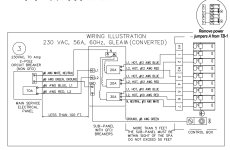5030tinkerer
Gold Member
My house is pre-wired for a spa. Trouble is, that the wiring is 6/3 and behind sheetrock (of course it is). With 6/3 comes 6 gauge hot in red, 6 gauge hot in black, a 6 gauge neutral, and a bare 10 gauge ground. The installation directions (http://www.olympicho...manual_2013.pdf) for the spa indicate #6 wire for all four of these wires for wire distances of up to 100'.
I measured my wire length from my main electrical service panel to where the spa panel would be and came in at 34 feet. From http://www.calculato...es=50&x=64&y=13, it would seem that the electrical carrying ability of #10 wire is greater at this distance than #6 wire has at 100 feet since the voltage drop is half a point less with the 50 amp load I popped in there.
Am I stuck ripping open my wall or would this be a safe install as is?
Adding confusion is the following verbiage from p 14 of the install manual (when the diagram on the following page calls for #6): 'An electrical subpanel containing two GFcI breakers is included with each spa. We recommend that this subpanel be used to supply power and protect the spa. This subpanel requires a 70 amp, single phase, 230 volt, four wire service (two line, one neutral, one ground). The ground wire must never be less
than #10 AWG. use Nec 250-122 (table) and local codes for more information. A minimum #6 AWG solid copper bond wire is also required.'
The NEC table can be found at http://www.safecoelectric.com/images/resources_pdf/NEC2008 Table 250.122.pdf and indicates that #10 wire is good for up to 60 amp service (but again this is designed for 100' wire lengths).
I measured my wire length from my main electrical service panel to where the spa panel would be and came in at 34 feet. From http://www.calculato...es=50&x=64&y=13, it would seem that the electrical carrying ability of #10 wire is greater at this distance than #6 wire has at 100 feet since the voltage drop is half a point less with the 50 amp load I popped in there.
Am I stuck ripping open my wall or would this be a safe install as is?
Adding confusion is the following verbiage from p 14 of the install manual (when the diagram on the following page calls for #6): 'An electrical subpanel containing two GFcI breakers is included with each spa. We recommend that this subpanel be used to supply power and protect the spa. This subpanel requires a 70 amp, single phase, 230 volt, four wire service (two line, one neutral, one ground). The ground wire must never be less
than #10 AWG. use Nec 250-122 (table) and local codes for more information. A minimum #6 AWG solid copper bond wire is also required.'
The NEC table can be found at http://www.safecoelectric.com/images/resources_pdf/NEC2008 Table 250.122.pdf and indicates that #10 wire is good for up to 60 amp service (but again this is designed for 100' wire lengths).

